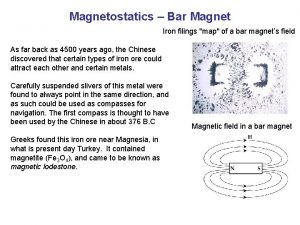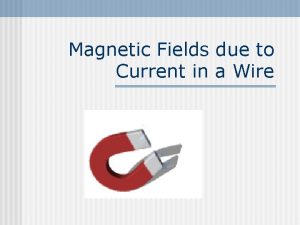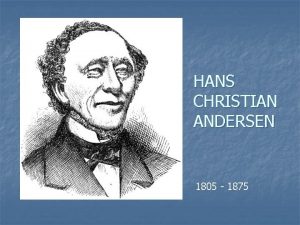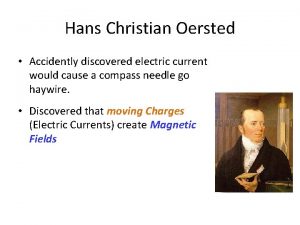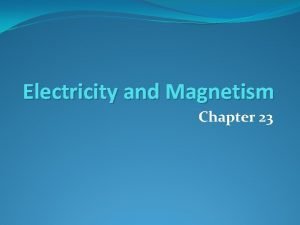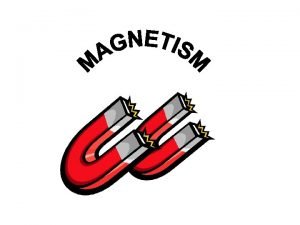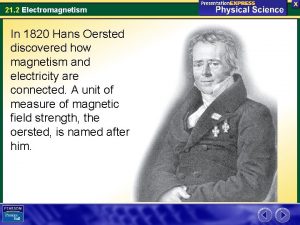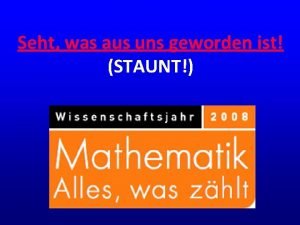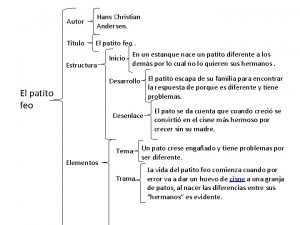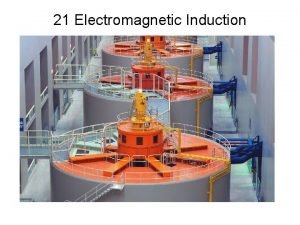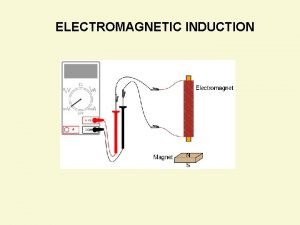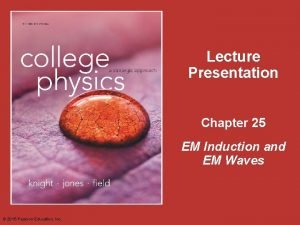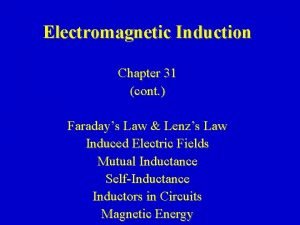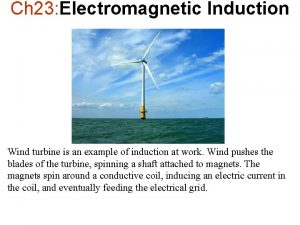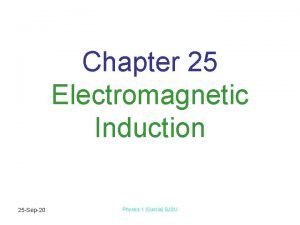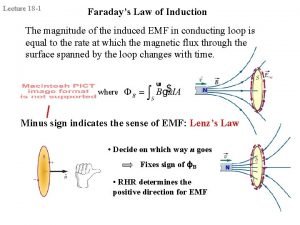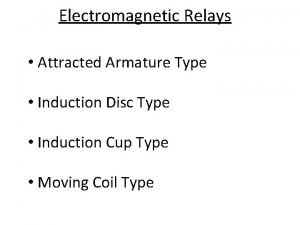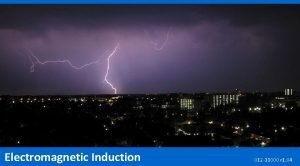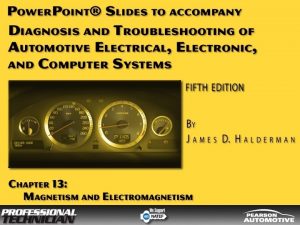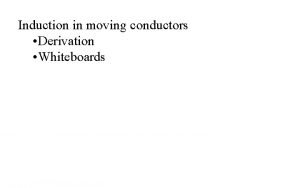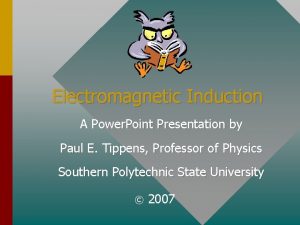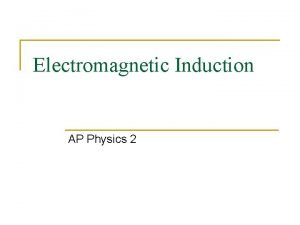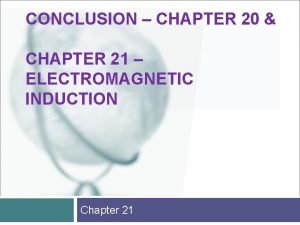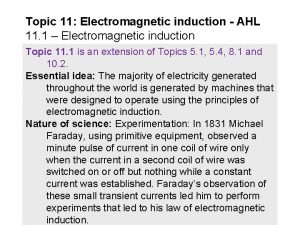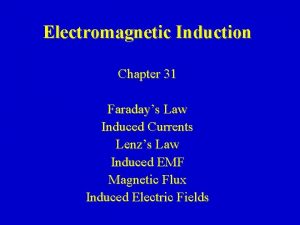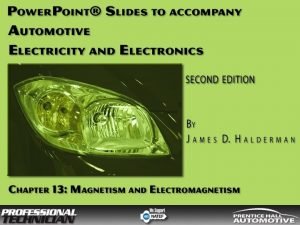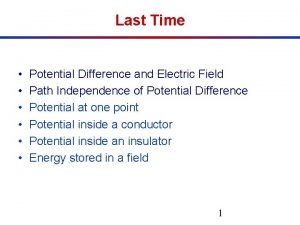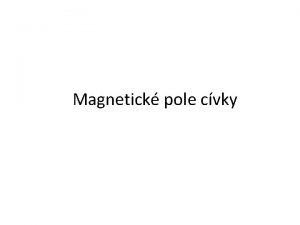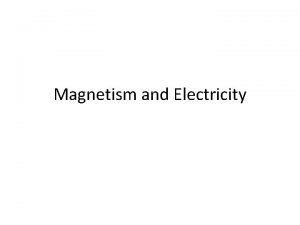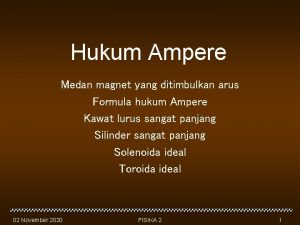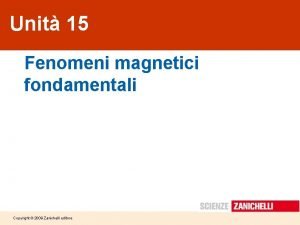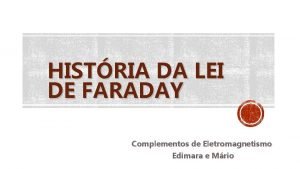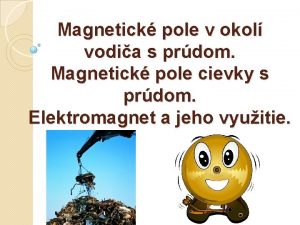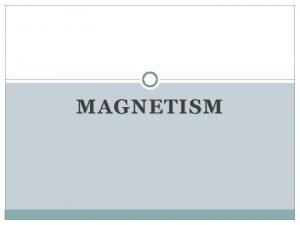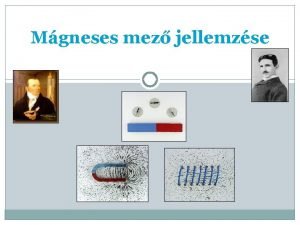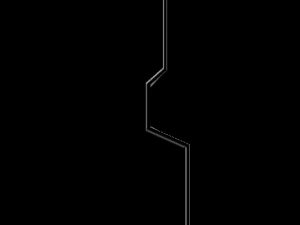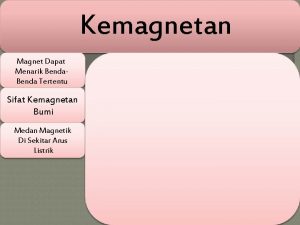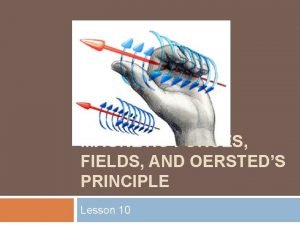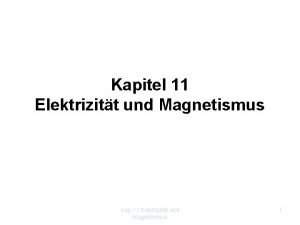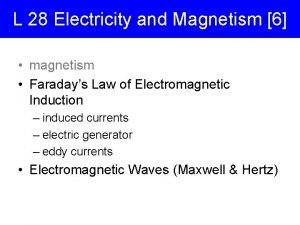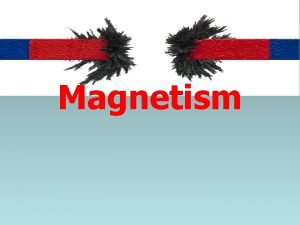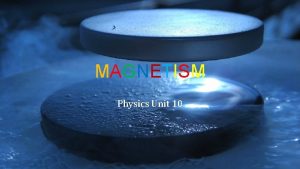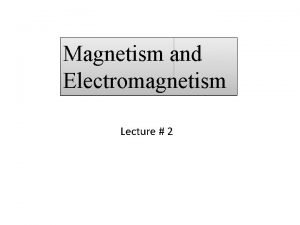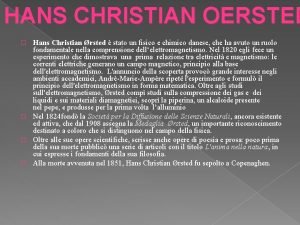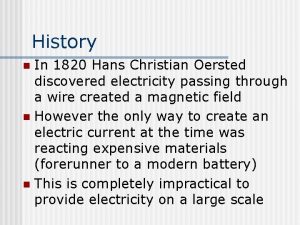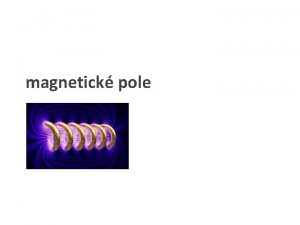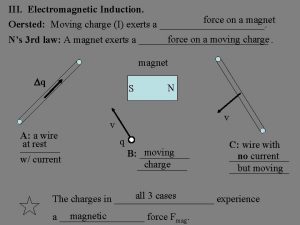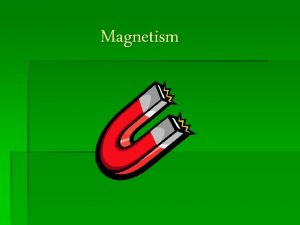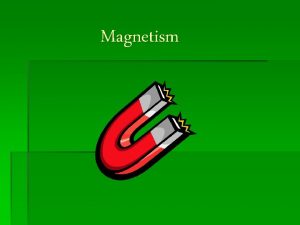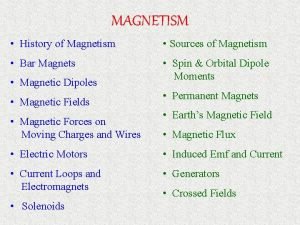Magnetism Electromagnetic Induction Electromagnetic Induction Hans Christian Oersted


























































- Slides: 58

Magnetism Electromagnetic Induction

Electromagnetic Induction Hans Christian Oersted discovered that an electric current produces a magnetic field Michael Faraday thought that the reverse must also be true: that a magnetic field produces an electric current In 1822, Michael Faraday wrote a goal in his notebook: “Convert magnetism into electricity” Faraday tried many combinations of magnetic fields and wires without success After nearly ten years of unsuccessful experiments, Faraday found that he could induce electric current by moving a wire through a magnetic field

Electromagnetic Induction In the same year, Joseph Henry, an American high-school teacher, also showed that a changing magnetic field could produce electric current Henry took an idea developed by another scientist and broadened the application to other educational demonstration devices to make them more sensitive or powerful Henry’s versions of these devices were not new discoveries, but he made the devices more dramatic and effective as educational aids However, Henry, unlike Faraday, chose not to publish his discoveries

Electromagnetic Induction

Electromagnetic Induction Electromotive Force When you studied electric circuits, you learned that a source of electrical energy, such as a battery, is needed to produce a continuous current The potential difference, or voltage, given to the charges by a battery is called the electromotive force, or EMF Electromotive force, however, is not actually a force; instead, it is a potential difference and is measured in volts Thus, the term electromotive force is misleading

Electromagnetic Induction Electromotive Force When you move a wire through a magnetic field, you exert a force on the charges and they move in the direction of the force Work is done on the charges. Their electrical potential energy, and thus their potential, is increased The difference in potential is called the induced EMF

Electromagnetic Induction Electromotive Force EMF depends on the magnetic field, B, the length of the wire in the magnetic field, L, and the velocity of the wire in the field that is perpendicular to the field, v(sin θ) Electromotive Force EMF = BLv(sin θ) The unit for measuring EMF is the volt, V

Electromagnetic Induction Electromotive Force If a wire moves through a magnetic field at an angle to the field, only the component of the wire’s velocity that is perpendicular to the direction of the magnetic field generates EMF If the wire moves through the field with a velocity that is exactly perpendicular to the field, then the equation reduces to EMF = BLv, because sin 90° = 1

Electromagnetic Induction Electric Generators The electric generator, invented by Michael Faraday, converts mechanical energy to electrical energy An electric generator consists of a number of wire loops placed in a strong magnetic field The wire is wound around an iron core to increase the strength of the magnetic field The iron and the wires are called the armature, which is similar to that of an electric motor

Electromagnetic Induction Electric Generators The armature is mounted so that it can rotate freely in the magnetic field As the armature turns, the wire loops cut through the magnetic field lines and induce an EMF Commonly called the voltage, the EMF developed by the generator depends on the length of the wire rotating in the field Increasing the number of loops in the armature increases the wire length, thereby increasing the induced EMF Note that you could have a length of wire with only part of it in the magnetic field. Only the portion within the magnetic field induces an EMF

Electromagnetic Induction Current from a Generator When a generator is connected in a closed circuit, the induced EMF produces an electric current The direction of the induced current can be found from the third righthand rule As the loop rotates, the strength and the direction of the current change

Electromagnetic Induction Current from a Generator The figure below shows the amount of current generated by a rotating wire loop

Electromagnetic Induction Current from a Generator The current is greatest when the motion of the loop is perpendicular to the magnetic field. That is, when the loop is in the horizontal position, as shown in the figure In this position, the component of the loop’s velocity perpendicular to the magnetic field is greatest

Electromagnetic Induction Current from a Generator As the loop rotates from the horizontal to the vertical position, as shown in the figure, it moves through the magnetic field lines at an ever-increasing angle Thus, it cuts through fewer magnetic field lines per unit of time, and the current decreases

Electromagnetic Induction Current from a Generator When the loop is in the vertical position, the wire segments move parallel to the field and the current is zero As the loop continues to turn, the segment that was moving up begins to move down and reverses the direction of the current in the loop This change in direction takes place each time the loop turns through 180°

Electromagnetic Induction Current from a Generator The current changes smoothly from zero to some maximum value and back to zero during each half-turn of the loop. Then it reverses direction A graph of current versus time is shown in the figure

Electromagnetic Induction Current from a Generator Does the entire loop contribute to the induced EMF? Look at the figure, where all four sides of the loop are depicted in the magnetic field

Electromagnetic Induction Current from a Generator If the fourth right-hand rule is applied to segment ab, the direction of the induced current is toward the side of the wire The same applies to segment cd. Thus, no current is induced along the length of the wire in ab or cd But in segment bc, the direction of the induced current is from b to c, and in segment ad, the current is from d to a

Electromagnetic Induction Current from a Generator Because the conducting loop is rotating in a circular motion, the relative angle between a point on the loop and the magnetic field constantly changes The electromotive force can be calculated by the electromotive force equation given earlier, EMF = BLv(sin θ), except that L is now the length of segment bc The maximum voltage is induced when a conductor is moving perpendicular to the magnetic field and thus θ = 90°

Electromagnetic Induction Current from a Generators and motors are almost identical in construction, but they convert energy in opposite directions A generator converts mechanical energy to electrical energy, while a motor converts electrical energy to mechanical energy

Electromagnetic Induction Alternating Current Generators An energy source turns the armature of a generator in a magnetic field at a fixed number of revolutions per second In the United States, electric utilities use a 60 -Hz frequency, in which the current goes from one direction to the other and back to the first 60 times per second

Electromagnetic Induction Alternating Current Generators The figure shows how an alternating current, AC, in an armature is transmitted to the rest of the circuit The brush-slip-ring arrangement permits the armature to turn freely while still allowing the current to pass into the external circuit

Electromagnetic Induction Alternating Current Generators As the armature turns, the alternating current varies between some maximum value and zero, as shown in the graph

Electromagnetic Induction Average Power The power produced by a generator is the product of the current and the voltage Because both current and voltage vary, the power associated with an alternating current varies

Electromagnetic Induction Average Power The figure shows a graph of the power produced by an AC generator Note that power is always positive because I and V are either both positive or both negative

Electromagnetic Induction Alternating Current Generators Average power, PAC, is half the maximum power; thus:

Electromagnetic Induction Effective Voltage and Current It is common to describe alternating current and voltage in terms of effective current and voltage, rather than referring to their maximum values Recall that P = I 2 R. Thus, you can express effective current, Ieff, in terms of the average AC power as PAC = Ieff 2 R

Electromagnetic Induction Effective Voltage and Current To determine Ieff in terms of maximum current, Imax, start with the power relationship, and substitute in I 2 R. Then solve for Ieff Effective Current

Electromagnetic Induction Effective Voltage and Current Similarly, the following equation can be used to express effective voltage Effective Voltage Effective voltage also is commonly referred to as RMS (root mean square) voltage

Electromagnetic Induction Effective Voltage and Current In the United States, the voltage generally available at wall outlets is described as 120 V, where 120 V is the magnitude of the effective voltage, not the maximum voltage The frequency and effective voltage that are used vary in different countries

Electromagnetic Induction Lenz’s Law Consider a section of one loop that moves through a magnetic field, as shown in the figure

Electromagnetic Induction Lenz’s Law An EMF, equal to BLv, will be induced in the wire If the magnetic field is out of the page and velocity is to the right, then the fourth right-hand rule shows a downward EMF, as illustrated in the figure, and consequently a downward current is produced

Electromagnetic Induction Lenz’s Law To determine the direction of this force, use third right-hand rule: if current, I, is down and the magnetic field, B, is out, then the resulting force is to the left, as shown in the figure

Electromagnetic Induction Lenz’s Law This means that the direction of the force on the wire opposes the original motion of the wire, v That is, the force acts to slow down the rotation of the armature The method of determining the direction of a force was first demonstrated in 1834 by H. F. E. Lenz and is, therefore, called Lenz’s law

Electromagnetic Induction Lenz’s Law Lenz’s law states that the direction of the induced current is such that the magnetic field resulting from the induced current opposes the change in the field that caused the induced current Note that it is the change in the field and not the field itself that is opposed by the induced magnetic effects

Electromagnetic Induction Motors and Lenz’s Law Lenz’s law also applies to motors When a current-carrying wire moves in a magnetic field, an EMF is generated This EMF, called the back-EMF, is in a direction that opposes the current

Electromagnetic Induction Motors and Lenz’s Law When a motor is first turned on, there is a large current because of the low resistance of the motor As the motor begins to turn, the motion of the wires across the magnetic field induces a back-EMF that opposes the current Therefore, the net current through the motor is reduced

Electromagnetic Induction Motors and Lenz’s Law If a mechanical load is placed on the motor, as in a situation in which work is being done to lift a weight, the rotation of the motor will slow This slowing down will decrease the back-EMF, which will allow more current through the motor

Electromagnetic Induction Motors and Lenz’s Law When a motor is first turned on, there is a large current because of the low resistance of the motor As the motor begins to turn, the motion of the wires across the magnetic field induces a back-EMF that opposes the current Therefore, the net current through the motor is reduced

Electromagnetic Induction Motors and Lenz’s Law If a mechanical load is placed on the motor, as in a situation in which work is being done to lift a weight, the rotation of the motor will slow This slowing down will decrease the back-EMF, which will allow more current through the motor Note that this is consistent with the law of conservation of energy: if current increases, so does the rate at which electric power is being sent to the motor This power is delivered in mechanical form to the load If the mechanical load stops the motor, current can be so high that wires overheat

Electromagnetic Induction Application of Lenz’s Law

Electromagnetic Induction Self-Inductance Back-EMF can be explained in another way As Faraday showed, EMF is induced whenever a wire cuts the lines of a magnetic field

Electromagnetic Induction Self-Inductance The current generates a magnetic field, shown by magnetic field lines As the current and magnetic field increase, new lines are created As more lines are added, they cut through the coil wires and generate an EMF to oppose the current changes The EMF will make the potential of the top of the coil more negative than the bottom This induction of EMF in a wire carrying changing current is called self-inductance

Electromagnetic Induction Self-Inductance The size of the induced EMF is proportional to the rate at which field lines cut through the wires The faster the current is changed, the larger the opposing EMF If the current reaches a steady value, the magnetic field is constant, and the EMF is zero

Electromagnetic Induction Self-Inductance When the current is decreased, an EMF is generated that tends to prevent the reduction in the magnetic field and current Because of self-inductance, work has to be done to increase the current flowing through the coil Energy is stored in the magnetic field. This is similar to the way in which a charged capacitor stores energy in the electric field between its plates

Electromagnetic Induction Transformers are used to increase or decrease AC voltages Usage of transformers is common because they change voltages with relatively little loss of energy In fact, many of the devices in your home, such as game systems, printers, and stereos, have transformers inside their casings or as part of their cords

Electromagnetic Induction How Transformers Work Self-inductance produces an EMF when current changes in a single coil A transformer has two coils, electrically insulated from each other, but wound around the same iron core One coil is called the primary coil, while the other coil is called the secondary coil

Electromagnetic Induction How Transformers Work When the primary coil is connected to a source of AC voltage, the changing current creates a changing magnetic field, which is carried through the core to the secondary coil In the secondary coil, the changing field induces a varying EMF. This effect is called mutual inductance

Electromagnetic Induction How Transformers Work The EMF induced in the secondary coil, called the secondary voltage, is proportional to the primary voltage The secondary voltage also depends on the ratio of the number of turns on the secondary coil to the number of turns on the

Electromagnetic Induction How Transformers Work If the secondary voltage is larger than the primary voltage, the transformer is called a step-up transformer

Electromagnetic Induction How Transformers Work If the voltage coming out of the transformer is smaller than the voltage put in, then it is called a step-down transformer

Electromagnetic Induction How Transformers Work In an ideal transformer, the electric power delivered to the secondary circuit equals the power supplied to the primary circuit An ideal transformer dissipates no power itself, and can be represented by the following equations: Pp = Ps V p I p = V s. I s

Electromagnetic Induction How Transformers Work Rearranging the equation to find the ratio Vp/Vs shows that the current in the primary circuit depends on how much current is required by the secondary circuit This relationship can be combined with the relationship shown earlier between voltage and the number of turns to result in the following Transformer Equation

Electromagnetic Induction Everyday Uses of Transformers Long-distance transmission of electrical energy is economical only if low currents and very high voltages are used Step-up transformers are used at power sources to develop voltages as high as 480, 000 V High voltages reduce the current required in the transmission lines, keeping the energy lost to resistance low

Electromagnetic Induction Everyday Uses of Transformers When the energy reaches the consumer, step-down transformers, such as those shown in the figure, provide appropriately low voltages for consumer use

Electromagnetic Induction Everyday Uses of Transformers in home appliances further adjust voltages to useable levels If you have ever had to charge a toy or operate a personal electronic device, you probably had to plug a large “block” into the wall outlet A transformer of the type discussed in this chapter is contained inside of that block In this case, it is probably reducing the household voltage of about 120 V to something in the 3 -V to 26 -V range

Electromagnetic Induction Everyday Uses of Transformers Not all transformers are step-up or step-down Transformers can be used to isolate one circuit from another This is possible because the wire of the primary coil never makes direct contact with the wire of the secondary coil This type of transformer would most likely be found in some small electronic devices

Electromagnetic Induction A 21. 0 cm length of wire moves perpendicular to a 2. 45 T magnetic field at 3. 5 m/s. What is the magnitude of the EMF induced in the wire? The wire is part of a circuit with a total resistance of 3. 0 ohms. What is the current through the line? An AC generator produces a maximum voltage of 3. 00 x 102 V. What is the effective voltage in a circuit connected to the generator? If the resistance of the circuit is 53 ohms, what is the effective current in the circuit? A power source produces 8. 4 A of current with an internal resistance of 0. 60 ohms. This power source is connected to a transformer wit 35 turns on its primary coil and 1000 turns on its secondary coil. What is the average power output of this system when connected?
 Aportaciones de hans christian oersted
Aportaciones de hans christian oersted Hans christian oersted electromagnetism
Hans christian oersted electromagnetism Hans christian oersted experiment
Hans christian oersted experiment Hans christian oersted lebenslauf
Hans christian oersted lebenslauf Brajov
Brajov Hans christian oersted
Hans christian oersted Hans christian oersted
Hans christian oersted Oersted pokus
Oersted pokus Oersted law formula
Oersted law formula Hans christian oersted experiment
Hans christian oersted experiment Hans christian oersted quotes
Hans christian oersted quotes Hans oersted electricity
Hans oersted electricity Bajke hansa kristijana andersena
Bajke hansa kristijana andersena Andersen biografia dla dzieci
Andersen biografia dla dzieci Martin härterich
Martin härterich W którym wieku tworzył hans christian andersen
W którym wieku tworzył hans christian andersen Ruzni likovi
Ruzni likovi Hans christian andersen prezentacja
Hans christian andersen prezentacja Hans christian andersen steckbrief
Hans christian andersen steckbrief Hans christian andersen award winners
Hans christian andersen award winners Linda hoffman lekarz
Linda hoffman lekarz Patito feo caracteristicas
Patito feo caracteristicas Electromagnetic induction
Electromagnetic induction Electromagnetic induction
Electromagnetic induction Faraday's law of electromagnetic induction ppt
Faraday's law of electromagnetic induction ppt Faraday's law of electromagnetic induction
Faraday's law of electromagnetic induction Electromagnetic induction wind turbine
Electromagnetic induction wind turbine Electric generator electromagnetic induction
Electric generator electromagnetic induction Faraday law
Faraday law Hinged armature type relay
Hinged armature type relay Electromagnetic induction
Electromagnetic induction An ignition coil operates using the principle of
An ignition coil operates using the principle of Bvl physics
Bvl physics Electromagnetic induction ppt
Electromagnetic induction ppt Electromagnetic induction microphone
Electromagnetic induction microphone Conclusion of electromagnetic induction
Conclusion of electromagnetic induction Electromagnetic induction
Electromagnetic induction Explain faraday's law of electromagnetic induction
Explain faraday's law of electromagnetic induction An ignition coil operates using the principle of
An ignition coil operates using the principle of Oersted's experiment
Oersted's experiment Cvky
Cvky öersted
öersted Hukum ampere
Hukum ampere Interazioni magnetiche e campi magnetici zanichelli
Interazioni magnetiche e campi magnetici zanichelli Aragoos
Aragoos Oersted značka
Oersted značka Oersted osake
Oersted osake Oersted jele
Oersted jele Gaya oersted
Gaya oersted Gaya oersted
Gaya oersted Domain theory
Domain theory Erstedov pokus
Erstedov pokus Elektrische klingel
Elektrische klingel Magnetism
Magnetism F equals qvb
F equals qvb Electricity and magnetism
Electricity and magnetism Chapter 24 magnetism magnetic fundamentals answers
Chapter 24 magnetism magnetic fundamentals answers Magnetism
Magnetism Relative permeability of magnetic material
Relative permeability of magnetic material


